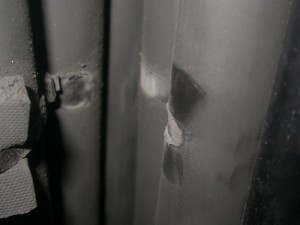Allowances should be made for all possible mechanical stresses that could occur during installation of a cable in order to minimize the risk of mechanical damage to the cables.
Tension
The following values for tension should not be exceeded by each conductor in use. This applies up to a maximum value of 1000 N for the tensile stress of all conductors unless the manufacturer has approved limits deviating from this value.
- 50 N/mm2 for fixed installation cables in permanent operation.
- 15 N/mm2 for flexible cables under static tension in fixed installations that are used in current circuits.

In these instances where the above values are exceeded, it is recommended that a separate strain-relieving element or similar protection system be used. The connection of such a strain-relieving element (strength membrane) prevents the cable from being damaged.
If flexible cables are subjected to dynamic tensile stress (including those due to the mass inertia, e.g. from reeling drums), the permissible tension or fatigue life should be agreed upon between the user and the manufacturer.
Notes for cables which are installed vertically, without any intermediate support, can be found in DIN VDE 0298 part 300 and HD 516 S2, item 5.4.1, and Table 6.
Bending stress
The internal bending radius of a cable should be chosen such that the cable is not damaged when bent. This is true for fixed and continuous flexing applications. The internal bending radii are given in Table 6 of HD 516 S2 and DIN VDE 0298 part 300. For bending radii smaller than specified, it is recommended that the user consult the manufacturer.
Attention should be given when stripping the insulation that the conductor is not damaged, as the bending characteristics may be affected.
The bending radius given applies to ambient temperatures of (20±10)°C. It is recommended that the user consult the manufacturer when operating in ambient temperatures other than those given.
For flexible cables, particularly at termination and machine points of entry, it may be necessary to use a device which ensures that the cable is not bent to an internal bending radius less than that specified in Table 6 of HD 516 S2 and DIN VDE 0298 part 300. Bending too close to any internal and/or external area where the cable is secured, should be avoided.
Kink-protection sleeves or other devices should not impede the movement of the conductors within the cable.
Compression
Cables should not be compressed to a point where the cable is damaged.
Torsional stress
In general, flexible cables are not designed for torsional stress. In cases where such torsional stress cannot be avoided, then the design of the cable and the installation arrangements should be agreed upon between user and the manufacturer.
Compatibility
The following points should be considered when selecting and installing cables:
- Avoid interfering with the mechanical and electrical influences between adjacent circuits.
- Cable heat dissipation, or the chemical/physical properties of the materials used in the cables, on nearby materials, e.g. construction and decorative materials, insulation tubes, supports, etc.
- Mutual interference by adjacent materials and the materials used in the cables. This applies in instances such as the absorption of plasticizers from PVC-jacketed cables by certain materials that are used in thermal insulation purposes, or for tying materials to the equipment.
Current overload
Users should take into account the possibility that cables and their attachments could be damaged by any overload of current, including short-circuits.
Storage/Handling/Transportation
Cables that are not intended for outdoor applications should be stored in dry, indoor environments.
A number of flexible cables are particularly susceptible to moisture, such as shielded cables for example. In order to prevent the penetration of moisture, the ends of the cables should be capped during outdoor storage. Suitable storage temperatures can be found in the tables located in HD 516 S2.
If the temperature of the cable falls below recommended values, then all types of mechanical stresses, including vibration, shock, impact, bending and torsion/twisting should be avoided.
Read part 1 in this series here, part 2 here, part 3 here and part 4 here.
Contributed by Kevin Siegel, Communications Manager
Helukabel USA
www.helukabel.com


Leave a Reply
You must be logged in to post a comment.